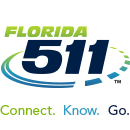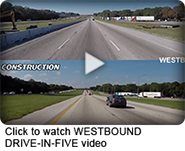|
|
|
|
I-4 Ultimate Construction at Kirkman Road Nears Halfway Mark
|
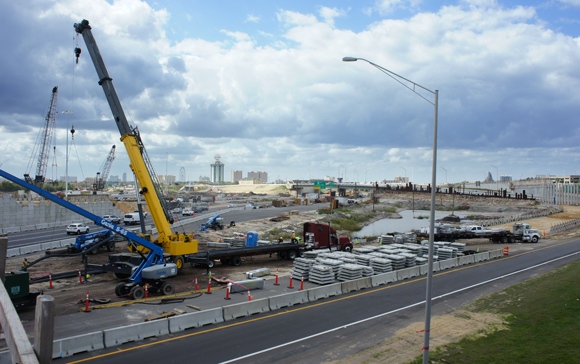
|
A new overpass for southbound Kirkman Road (State Road 435) at the Interstate 4 (I-4) interchange was opened earlier this month, as the I-4 Ultimate project continues the remarkable pace of remaking this busy gateway to Orlando’s world-class attractions.
In less than two years of construction, the Kirkman Road interchange is more than 40 percent complete. Accompanying the newly opened southbound overpass are the northbound overpass and a westbound I-4 exit to northbound Kirkman Road. By the end of the year, a new westbound I-4 exit to southbound Kirkman Road and the nearby Grand National Drive overpass will be completed.
The new overpass will serve the growing International Drive business community and the nearby attractions. The overpass will connect Grand National Drive to Caravan Court and will feature Express Lane direct access in the eastbound direction from Grand National Drive and the westbound direction to Grand National Drive. Additional ramps will be constructed in anticipation of the future Express Lane extension west on I-4.
Pedestrian access will be a pronounced feature of the new Grand National Drive overpass. Sidewalks on both sides of the bridge will allow tourists to easily stroll from the hotels on Caravan Court to the plethora of shops, restaurants and attractions along International Drive.
Follow the progress of the I-4 Ultimate project at the Kirkman Road and Grand National Drive interchanges by watching the live, high-definition camera perched atop the SkyCoaster at Fun Spot America.
To see all the upcoming improvements at the Kirkman Road and Grand National Drive interchanges, visit i4ultimate.com/futureKirkman.
|
|
|
Work Zone Safety is in Your Hands
|
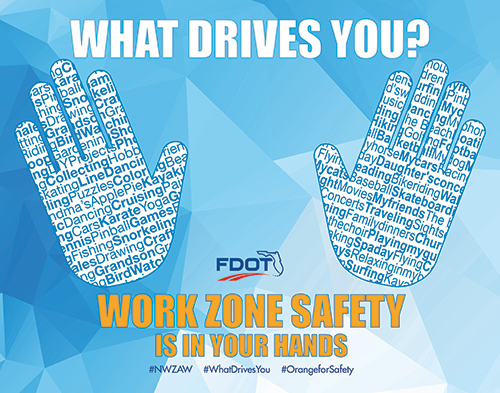 |
Every day across Central Florida, roadway workers who build, repair, and maintain our streets, bridges and highways expose themselves to the real-life dangers of working in and around ongoing traffic.
They’re not the only ones facing hazardous conditions, however. Work zones present a number of challenging situations for motorists driving through the complex array of signs, barrels and lane changes.
More than 40,000 people are injured each year as a result of motor vehicle crashes in work zones nationwide. The Florida Department of Highway Safety and Motor Vehicles reports that 99 percent of work zone crashes injure drivers and their passengers, not roadside workers.
The good news is, most crashes in construction zones are preventable. A few minor changes can make sure everyone gets home safely at the end of the day.
Adjust your Speed – Traveling 10 miles per hour above the posted work zone speed limit shaves less than three minutes off a 20-mile trip and carries a minimum fine of $200, plus court fees.
Don’t Tailgate – More than half of all work zone crashes are rear end collisions. Passenger vehicles traveling at 50 mph require 300 feet of stopping distance on dry roads. A loaded tractor-trailer needs 450 feet to come to a complete stop.
Pay Attention – Work zones are changing environments. Travel lanes may be different from the last time you drove through the area. Added distractions like texting and talking on the phone, eating and drinking or adjusting the radio and navigation system divert your attention from the primary task of driving.
Remember when you’re behind the wheel, it is your decision to drive safely.
Show your commitment to keeping yourself and others safe on our roadways by wearing orange on Wednesday April 5, National Go Orange for Safety Day. Share your photos and stories by tagging them with #WhatDrivesYou.
|
|
|
I-4 Ultimate Completes Second Year of Construction
|
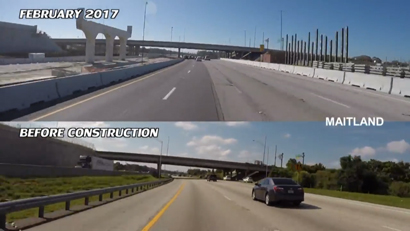 |
After breaking ground on Feb. 17, 2015, the I-4 Ultimate project has steadily gained momentum, as workers revamp, rebuild and expand 21 miles of Interstate 4 (I-4) to increase safety and mobility for motorists and improve connections between communities.
When the project finishes in 2021, it will feature 15 major rebuilt interchanges, 140 bridges reconstructed or replaced and four dynamically tolled express lanes (two in each direction). That will increase the total number of lanes from six to 10 in the $2.3 billion public-private project overseen by the Florida Department of Transportation (FDOT).
“Our message to commuters and residents is that we are on track, on time and continuing to progress as quickly and safely as possible,” said Loreen Bobo, P.E., who is FDOT’s Construction Program Manager for the project.
Bobo praised the professionalism of the I-4 Ultimate team and the patience of commuters and travelers, as the team builds temporary ramps, helps plan and conducts rolling roadblocks and continues construction while keeping six lanes open during daylight hours, which can include heavy travel periods.
“We’ve had one hurricane, many powerful thunderstorms and dozens of holidays that have stopped or limited our work hours, but we are right on schedule,” Bobo said. “We will continue to work as safely and as efficiently as possible to create a memorable corridor for residents and motorists. And we thank the community for its patience and for its appreciation of our ultimate goal.”
While the I-4 team remains committed to maintaining the safety of workers and drivers, FDOT also reminds motorists to stay alert for traffic shifts and message signs during the ongoing construction of the largest infrastructure project in Florida’s history.
For much of the first year, work focused on underground structures and support – all the networks of piping and pilings that create the foundation for later work. Large pipes carry off stormwater, preventing the pavement from flooding. Steel pilings, driven underground, help support roads, bridges and ramps, stabilizing the structure for decades to come.
While underground work will continue and remain hidden from view, the I-4 Ultimate construction team has also made many noticeable changes above ground all along the 21-mile project that ranges from west of Kirkman Road to east of State Road (S.R.) 434.
The complete list of significant accomplishments is too long to mention here. However, some of the highlights include significant changes in Maitland, where work is requiring 20 shifts in traffic patterns, and at the interchange with S.R. 408 – a complicated effort within a tight workspace in downtown Orlando.
Work also is underway to build a signature bridge over I-4 at Lake Ivanhoe to function as a gateway to the City Beautiful and a specially designed pedestrian bridge in Maitland.
New bridges have been built over New Hampshire Street, Kirkman Road and several others are heading toward completion. New ramps were opened on several roads, including Fairbanks Avenue (S.R. 426) and Lee Road (S.R. 423). Moreover, there will be even greater changes during the third year of construction.
|
|
|
A Look Ahead at the Improved Colonial Drive Interchange
|
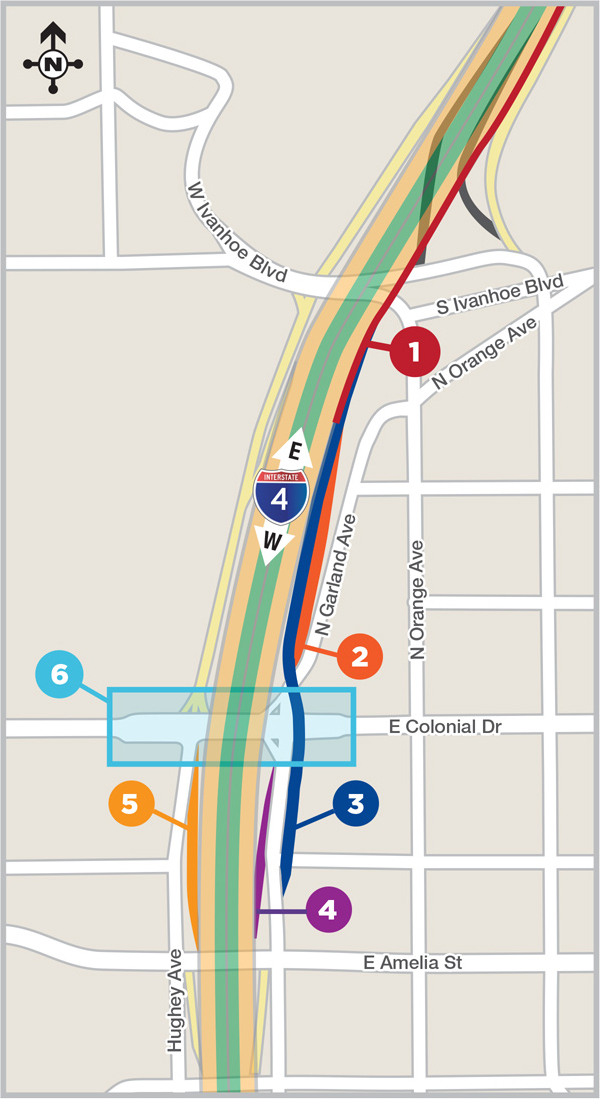 |
| 1 |
Adding an acceleration lane on eastbound I-4 from Colonial Drive to Princeton Street improves the capacity of the I-4 general use lanes. |
| 2 |
The entrance ramp from Colonial Drive to eastbound I-4 now occurs north of Colonial Drive. |
| 3 |
Reconfiguring the entrance ramp from Garland Avenue north of Amelia Street to eastbound I-4 allows traffic to fly over the Colonial Drive interchange with direct access to eastbound I-4. |
| 4 |
An eastbound exit ramp off of I-4 will allow direct access to turn left onto Colonial Drive. |
| 5 |
Adding an entrance ramp from Hughey Avenue to westbound I-4 at Colonial Drive improves access to I-4. |
| 6 |
Reconfiguring the interchange as a single-point urban interchange (SPUI) under I-4 allows all left-hand traffic movements to be controlled by a single traffic signal. Lanes on Colonial Drive will be wider (11-foot). |
|
Recognizing the importance of Colonial Drive (State Road 50) to motorists, residents and businesses, the Florida Department of Transportation (FDOT) is completely rebuilding the interchange of Colonial Drive and Interstate 4 (I-4) in downtown Orlando.
The change will be dramatic and will include I-4 entrance and exit ramps, as well as a complete makeover of the Colonial Drive intersection near and directly under the I-4 bridge.
The redesign is part of the I-4 Ultimate project, which is reconstructing a 21-mile segment of I-4 to increase safety and mobility throughout Central Florida. When completed, the Colonial Drive interchange will look significantly different. But the new configuration will allow for a more efficient flow of traffic on to and off I-4, along the new highway lanes, and on Colonial Drive.
One of the major changes will involve removing the looping ramps from westbound Colonial Drive to westbound I-4 and from eastbound Colonial Drive to eastbound I-4. They will be replaced with simpler, straighter ramps.
The rebuilding of the interchange involves many significant changes that may seem complicated, but they will create a more efficient interchange, as the accompanying maps and renderings show.
On the westbound side of I-4:
- Entrance ramp at Hughey Avenue will be added to westbound I-4.
- A new frontage road between Ivanhoe Boulevard and Colonial Drive will allow westbound I-4 motorists to exit onto Colonial Drive.
On the eastbound side:
- An eastbound I-4 exit ramp will allow direct access to turn left onto Colonial Drive.
- The eastbound I-4 entrance ramp from Garland Avenue will fly over the Colonial Drive interchange. That will allow motorists to enter on the right instead of the left.
- The eastbound I-4 entrance ramp from Colonial Drive will move slightly north of Colonial Drive.
- A new acceleration lane from Colonial Drive to Princeton Street will allow more time to merge into the general use lanes.
There will be large-scale changes on Colonial Drive beneath the I-4 bridge, which will be remade into a single-point urban interchange (SPUI).
A SPUI is a type of interchange that is used to move large traffic volumes safely and efficiently through an intersection with limited amount of space. A SPUI allows opposing left turns to proceed simultaneously in one single intersection, which is over or under the free-flowing road. The name “single-point” refers to the fact that all through traffic on the arterial street, as well as the traffic turning left onto or off the interchange, can be controlled from a single set of traffic signals.
For more information about the planned improvements at the Colonial Drive interchange, visit i4ultimate.com/FutureColonial.
|
|
|
Spotlight Employee: Heather Thorne
HEATHER THORNE
Heather Thorne
Welder, Area 3
Resides: Bushnell
|
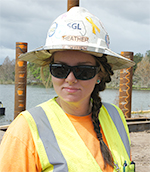
“It’s cool to see all the parts coming together.” |
|
|
On any given workday, commuters passing through downtown Orlando are likely to find Heather Thorne working off to the side of Interstate 4 by the shore of Lake Ivanhoe, operating a welding torch that burns several hundred degrees hotter than the Florida heat and sends sparks flying.
For safety, she’ll be wearing a hard hat, protective welding hood, gloves and heavy leather coverings – all adding to a heat index that can top 100 degrees on summer days. For Thorne, dealing with heat is just part of the job, something she’s learned during 10 years of welding. It adds to her sense of accomplishment.
“It’s cool to see all the parts coming together and becoming something big,” she said, pointing to the scene around her, where steel and concrete seem to be sprouting from the ground on their way to becoming ramps and bridges.
She often welds sections of steel pilings that have been driven deep into the ground to support those bridges. Piles may extend more than 300 feet deep, so several sections must be welded together, as they are driven into the soil.
To do so, a crane lowers each heavy section of piling, and Thorne and her fellow welders guide it to the right spot. They then fuse the new piece to the end protruding from the ground. Powerful hammers drive or vibrate the welded steel farther below ground. At other times, Thorne may be cutting through thick steel or welding together long beams to create templates used to guide the heavy piles into their exact location.
Thorne enjoys her work for SGL – the construction joint venture of Skanska, Granite and Lane. “I get to build things and I like being outside,” said the Bushnell resident.
In her spare time, Thorne and her boyfriend raise and train quarter horses. She also works with her father, who created and sells a special cart for hunters. Her dad, a former welder, inspired her to learn the trade.
Years ago, when Thorne passed one of her first qualifying tests as a welder, she gave him the piece of fused metal she had worked on. “He still has it.”
|
|
|
|
|
|







